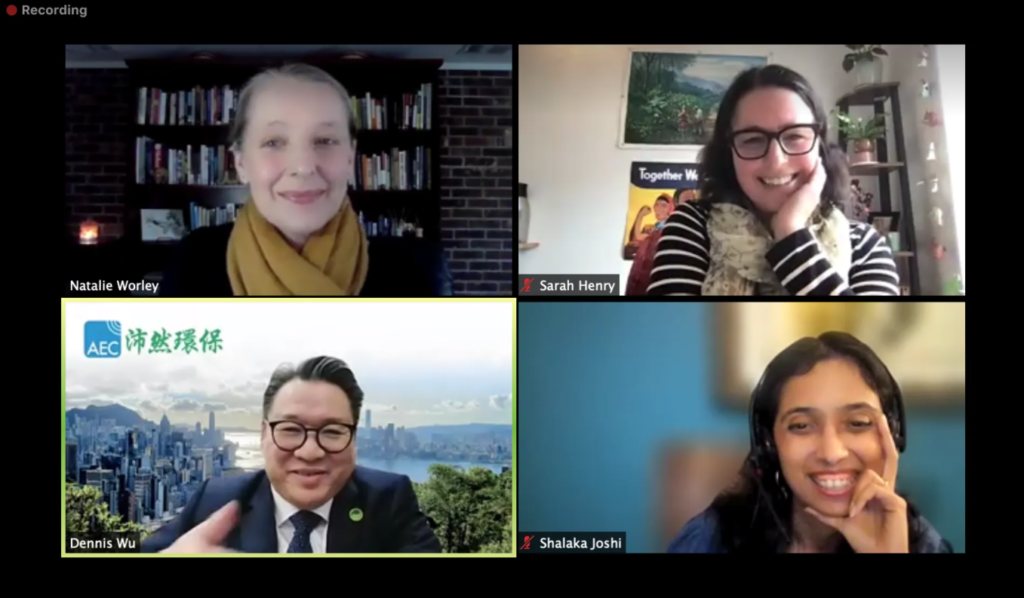November 30th 2021 – IIRR Webinar: The Gender Dimension of the Pandemic in Rural Asia
Today IIRR hosted a panel of experts to discuss how COVID-19 has been impacting women, and particularly women’s human security, in different parts of the Asia region. IIRR strongly believes in the importance of convening experts around key topics in order to further collaborative discussion and share information on evolving issues. This webinar, hosted by IIRR’s Natalie Worley, brought together a variety of perspectives surrounding the gendered dimensions of COVID-19 in rural areas.

Sarah Henry, the Executive Director for the Global Center for Gender Equality at Stanford University, Shalaka Joshi, the Gender and Economic Inclusion Lead (South Asia) for the International Finance Corporation, and Dennis WU, the Vice-Chairman and Executive Director of AEC Group and Founder and CEO of AEC Capital Group each presented their overview of the key issues before the floor was opened to the audience for questions.
Shalaka succinctly highlighted the underlying gender gaps across Asia, and the barriers to closing those gaps. Women’s participation in work outside of the domestic sphere is key for female empowerment and also will unlock GDP for Asian countries. Although female labour force participation varies hugely across the diverse continent, what the vast majority of women have in common is the burden of disproportionate care responsibility in the domestic sphere. Indeed, women in Asia are estimated to dedicate 3.2x more hours to unpaid care work than men – an enormous burden of care. This unpaid domestic care load was then greatly exacerbated during the pandemic, accompanied by increases in gender-based violence in the home.

Dennis added a climate perspective to this, showing how women were facing specific challenges stemming from climate change, which the pandemic compounded. He focussed on Asian women working on rural farms. Over the last couple of decades women have been taking on more agricultural tasks as men migrate to cities for work. Climate change-linked droughts, severe weather events, and weather unpredictability have made agricultural sustenance more difficult. Then during COVID women faced challenges accessing markets to sell products or buy essential inputs. Food prices rose whilst purchasing power remained limited and access to larger scale credit was impossible. Meanwhile, women and girls were expected to care for the sick, adding extra stress and fatigue to their lives. Dennis also highlighted the gender divide with regards to information, noting that women generally were less able to access COVID-19 updates than men. In Bangladesh, for example, over 50% of women are estimated to rely on their husbands entirely for news and information regarding the pandemic.
Sarah underscored a key message which the other two panellists had also argued: [1] there is a huge lack of gender-specific data and [2] there is a paucity of gender-specific analyses of existing data. Existing data is often not specific enough for researchers to really get into the gendered dimensions, or indeed dimensions of class, race, or socio-economic background, all of which are crucial to account for and unpack. Data analysis with a truly intersectional lens requires that data collection is done with these goals at the fore. Then organizations and companies need to design interventions, policies, programs to intentionally to address the gendered dimensions. Smarter analysis of existing data in is important for turning intentions and goals around female empowerment into action. Data analysis must be based around rural women’s specific needs and contexts.

The speakers also emphasized instances of progress and opportunity for rural women during COVID-19. For example, Shalaka drew attention to the success of Dot and Line, a women-owned start-up in Pakistan. Dot and Line was created by Maheen Adamjee and Lina Ahmed who sought to address the low learning outcomes of Pakistan’s 30 million school-going children. When COVID began spreading across the globe, the women anticipated the upcoming lockdown and were able to move to a fully virtual office setup weeks before the actual stay-at-home order was issued. They trained their 200 female home-based teachers to become adept at online tutoring and presenting, such that their education work could continue. Signups for online classes soared and their company was able to persist with its mission. Examples like these highlight the importance of women’s leadership in ensuring that specific needs are addressed in the design and implementation response measures to the pandemic.
To learn more about our panellists and their work, follow the links below.



